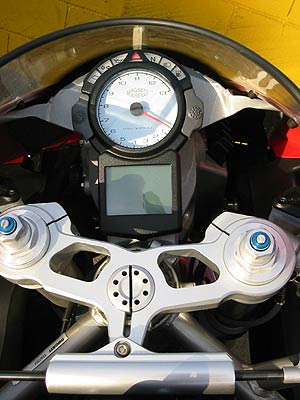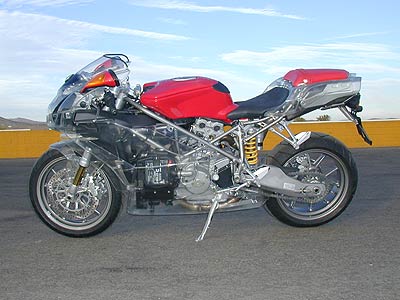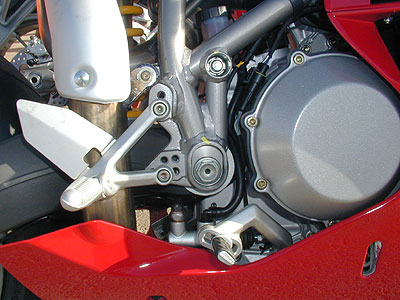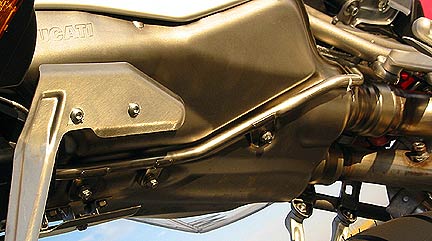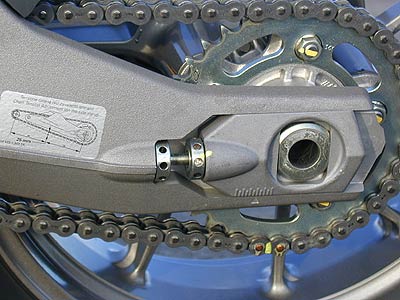Ducati 999 At Willow, Part 2
The Ducati 999 On The Stand:
The biggest innovation on the 999 is the adoption of a car technology to a production motorcycle: CAN or Controller Area Network. I know it might be hard to work up much enthusiasm for the wiring harness but what they have done is a bigger step forward than those compact coils on sparkplugs that we have all come to love so much. Instead of having a wiring loom with a sensor, wires, and receptors for each separate function, a CAN uses digital signals, single sensors and two computers which sort out which signals are to be used for each function. For example, on a conventional bike there are three temperature sensors for the coolant: one for the fuel injection, one for the temperature gauge and one to turn on the fan. By comparison, on the new Ducati there is a single coolant sensor which feeds digital data into the network. That data is then utilized by the ECU for the fuel injection and control of the fans. The same data is used by the instrument cluster to display the engine temperature on the large LCD. This system is very versatile since it is much easier to improve software than to improve hardware. The integral lap timer built into the instrument cluster of the 999 requires no additional hardware (it uses the starter button switch and the LCD) it simply uses software to pick up and display information on hardware that is already there. The integral shift lights are also more of a software feature than a hardware feature. The reduction in wiring and sensors is not insignificant, Ducati has dropped 3 kilos off the electrical system with the adoption of CAN.
The waterproof instrument cluster is not just a display for information, it has sensors which feeds into the CAN as well, specifically, the atmospheric pressure sensor and the integrated immobilizer system which will prevent the bike from starting if the instrument does not detect a radio signal from a chip embedded in the ignition key. The instrument cluster also does a great job of providing the rider with information including a traditional looking tach, a speedometer, overrev (shift) lights and six other idiots lights. The fun stuff is the integrated lap timer which records the lap time, the highest speed, the highest RPM and the number of overrevs, all of which can be replayed in the pits. The lap timer is manually triggered by pushing the starter button but apparently there is also an IR receiver for auto triggering the lap timer. The LCD screen also displays the battery voltage, the need for engine servicing, fuel consumption and the actual FI error codes if the ECU detects a fault. The instrument cluster has menu buttons to toggle the various options of display. It is very sensible. I would expect to see an optional data logger to appear for this sort of system in the next couple years.
Maybe the next version with come with Tetris.
But the electronics is not part of the divisive new look. The fairing is. Andrea Forni explained the logic behind some of the new styling. According to Andrea, the 998 was already extremely aerodynamic and compact and it was going to be very difficult to make any improvements. The Ducati team focused their efforts on two factors, tucking the rider more closely behind the fairing with a narrower tank and lowering the seat 10mm while smoothing the turbulence generated by the front wheel. Enter those prominent flaps on the leading edge of the fairing. When the front wheel passes into still air it generates all sort of whirling vortexes and turbulence. This is bad and slows down the bike. The flaps capture that air and forces it to pass through the slits at the trailing edge of the flaps which smooths the air and reattaches it to the side of the bike. This is supposed to make the bike more aerodynamic at speed. It all seems like a lot of effort for a 1% improvement. The drag coefficient have now been reduced from 0.298 to 0.295. On the front of the bike, Andrea did not mention the headlights so I will assume that the stacked projectors was mostly a style choice. Of the four vents in the front of the fairing, the bottom two feed the airbox (“Ram air adds two bhp at maximum speed” –Forni) and the top two are “How do you say ‘design?’ ‘Style?’”.
If you like the way the motor looks more than the fairing, the clear panels are available from Ducati.
The second big departure from the 998 is the muffler. The muffler, which looks more automotive than motorcycle, has a very good engineering reason behind its non-traditional appearance. The dual oval mufflers of the older bikes, although aerodynamic, where leaving power on the table because they were not as big as they could be, and, thus, not as efficient as possible. The new muffler is shaped to fill the entire area under the seat greatly increasing the volume in the silencer (from 8.4 liters to 10.5 liters) which has increased the power output of the engine.
Adjustable rearsets, faux adjustable swingarm, plain clutch cover just begging for replacement. The yellow spring suggests Ohlins but the performance is Showa.
Other changes to the exhaust system include a three way catalytic converter which makes the Ducati burn extremely clean and asymmetrical header pipes. Usually header pipes of different lengths will hurt horsepower because the resonance of pressure waves (which help scavenging and, actually prevent over-scavenging in engine with lots of overlap in the cams) in the exhaust pipes can only happen, optimally, at one rpm. With asymmetrical headers the cylinders are usually working their best at different RPMs and peak horsepower will usually suffer.
The Ti one is in the catalog.
The Ducati engineers spoof equal length headers by changing the size of the front header pipe from 45mm to 55mm at exactly the same length of the rear header pipe. The step in the exhaust pipe diameter creates symmetrical pressure waves despite the disparate header pipe lengths.
On the intake side, the airbox has been increased from 9 liters to 12.5 liters while also changing from the old “gas tank is the airbox lid” to a more traditional fully enclosed air box. The former change is for power, the latter change is because the gas tank can now move as will be discussed more completely below.
The chassis is all new. The frame is about 10% stiffer. The ergonomics are adjustable and the swingarm is now dual sided. The traditional steel trellis frame remains with Showa suspension front and back. The stylish triple trees are also adjustable for rake by using replaceable inserts. The cast, dual-sided, 15mm longer swingarm sports a nice bit of engineering trickery. The chain adjuster move parallel to the ground, not the swingarm, thus, changing gearing does not affect the rear ride height. The rear-sets can be mounted in five different positions with the shift linkage and rear brake set-up adjusting to the various locations. One item which looks adjustable but is not is the swingarm pivot. Although the inserts are removable which would allow you to raise and lower the swingarm pivot in the frame, only the top race models with have the compatible crankcases with matching removable inserts to allow for actual repositioning of the swingarm pivot.
Changes in gearing no longer affect ride height.
On the single seater, the owner can choose to move the largest weight on the bike, the rider, forward or back by choosing different sets of bolt holes for the gas tanks and seat assembly. This allows the rider to move a great deal of weight forward or backwards for different handling characteristics.
The brakes have seen some mild revisions. The calipers are the triple bridged Brembo calipers off of the 2001 “R” model with four equal sized 34mm pistons and four separate pads per caliper. The 320mm rotors are a little lighter by being thinner (4.5mm) but Ducati has spaced the rotors out further into the air stream to prevent the warping problem sometimes associated with 4.5mm rotors. The rotors have less metal (more voids in the carrier) and have one less bolt holding them to the wheel. The rear brake is slightly more powerful with an increase in the rear disc size from 220 to 240mm.
Italians and their labels. Note stainless brake line and bridged caliper.
If you like the look, the high quality detailed engineering is just gravy. If you don’t like the look, the high quality detailed engineering still makes the bike desirable.


